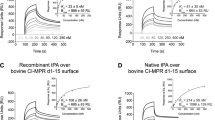Abstract
To identify and characterize endothelial cell surface components that bind plasminogen, we used ligand-blotting to study binding of plasminogen to sodium dodecyl sulphate solubilized extracts of human umbilical vein endothelial cells. It was observed that glu-plasminogen bound predominantly to a 45 kDa endothelial cell polypeptide. The interaction of labelled glu-plasminogen with this polypeptide was reversible and specific as the binding could be inhibited by both excess cold lysine and unlabelled glu-plasminogen but not by unrelated proteins. Binding of glu-plasminogen to cell extracts prepared from endothelial cells that had been pretreated with proteinase K was significantly reduced indicating that the 45 kDa polypeptide is a cell-surface protein. The cell-surface localization of the 45 kDa polypeptide was also indicated by the positive interaction of glu-plasminogen with membrane fractions of endothelial cells. Lys-plasminogen also interacted with the 45 kDa polypeptide in a specific manner and reversibility experiments indicated that lysplasminogen could also displace the bound glu-plasminogen. Since binding of plasminogen to the 45 kDa endothelial cell surface polypeptide was very similar to plasminogen binding to intact endothelial cells, we propose that the 45 kDa protein represents one of the major receptors for plasminogen on human endothelial cells.
Similar content being viewed by others
References
Castellino FJ: Biochemistry of human plasminogen. Sem Thromb Hemostat 10: 18–23, 1984
Robbins KC: The plasminogen-plasmin enzyme system. In: R.W. Coleman, J. Hirsh, V.J. Marder and E.W. Salzman (eds.) Hemostasis and Thrombosis. Basic Principles and Clinical Practice. J.B. Lippincott Company, Philadelphia, 1987, pp 340–357
Miles LA, Plow EF: Binding and activation of plasminogen on the platelet surface. J Biol Chem 260: 4303–4311, 1985
Miles LA, Ginsberg MH, White JG, Plow EF: Plasminogen interacts with human platelets through two distinct mechanisms. J Clin Invest 77: 2001–2009, 1986
Hajjar KA, Harpel PC, Jaffe EA, Nachman RL: Binding of plasminogen to cultured human endothelial cells. J Biol Chem 261: 11656–11662, 1986
Hajjar KA, Nachman RL: Endothelial cell-mediated conversion of glu-plasminogen to lys-plasminogen. Further evidence for assembly of the fibrinolytic system on the endothelial cell surface. J Clin Invest 82: 1769–1788, 1988
Ganz PR, Dupuis D, Dudani AK, Hashemi S: Differential binding of plasminogen to human endothelial cells. Blood 74: 40a, 1989
Ganz PR, Dupuis D, Dudani AK, Hashemi S: Characterization of plasminogen binding to human capillary and arterial endothelial cells. Biochem Cell Biol 69: 442–448, 1991
Miles LA, Plow EF: Receptor mediated binding of the fibrinolytic components, plasminogen and urokinase to peripheral blood cells. Thromb Haemostat 58: 936–942, 1987
Hall SW, Vandenberg SR, Gonias SL: Expression of plasminogen receptors on C6 glioma cells. Brain Res 495: 373–376, 1989
Gonias SL, Brand LL, Geary WA, Vandenberg SR: Plasminogen binding to rat hepatocytes in primary culture and to thin slices of rat liver. Blood 74: 729–736, 1989
Miles LA, Plow EF: Plasminogen receptors: Ubiquitous sites for the cellular regulation of fibrinolysis. Fibrinolysis 2: 61–71, 1988
Jaffe EA, Nachman RL, Becker CG, Minick CR: Culture of human endothelial cells derived from umbilical veins. Identification by morphologic and immunologic criteria. J Clin Invest 52: 2745–2756, 1973
Hashemi S, Tackaberry ES, Palmer DS, Rock G, Ganz PR: DDAVP-induced release of von Willebrand factor from endothelial cells in vitro: The effect of plasma and blood cells. Biochim Biophys Acta 1052: 63–70, 1990
Deutsch DG, Mertz ET: Plasminogen: Purification from human plasma by affinity chromatography. Science 170: 1095–1096, 1970
Ganz PR, Tackaberry ES, Palmer DS, Rock G: Human factor VIII from heparinized plasma. Purification and characterization of a single chain form. Eur J Biochem 170: 521–528, 1988
Bradford MM: A rapid and sensitive method for the quantitation of microgram quantities of protein utilizing the principle of protein-dye binding. Anal Biochem 72: 248–254, 1976
Laemmli UK: Cleavage of structural proteins during the assembly of the head of bacteriophage T4. Nature (Lond) 227:680–685, 1970
Takács BJ, Staehelin T: Biochemical characterization of cell surface antigens using monoclonal antibodies. Immunol Methods 2: 27–56, 1981
Miles LA, Dahlberg CM, Levin EG, Plow EF: Gangliosides interact directly with plasminogen and urokinase and may mediate binding of these fibrinolytic components to cells. Biochemistry 28: 9337–9343, 1989
Author information
Authors and Affiliations
Rights and permissions
About this article
Cite this article
Dudani, A.K., Hashemi, S., Aye, M.T. et al. Identification of an endothelial cell surface protein that binds plasminogen. Mol Cell Biochem 108, 133–140 (1991). https://doi.org/10.1007/BF00233117
Received:
Accepted:
Issue Date:
DOI: https://doi.org/10.1007/BF00233117



